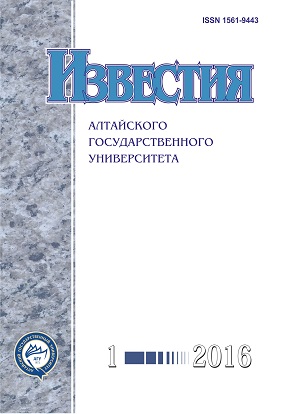Statistical Evaluation of Venous Thrombus Embolization Possibility
Abstract
In this paper, the risk assessment of venous thrombus embolization under phlebothrombosis and factors that lead to pulmonary embolism (PE) has been considered. The statistical model has been constructed using the results of non-specific clinical trials. The Neumann’s method of confidence intervals is utilized for selection of statistically significant differences among four data samples of patients with different diagnoses. Revealed statistically significant differences are used in further studies as a priori information for the development of PE risk profiles. Further studies are carried out using discriminant analysis. A complex of factors is revealed that has a maximum discriminating efficiency in PE determination for different categories of patients. The reliability of the results is evaluated by solving the identified systems of classification linear equations. Parameters commonly used in medical statistics, such as sensitivity and specificity, being the analogues of the first and second kind of errors are also evaluated.
DOI 10.14258/izvasu(2016)1-33
Downloads
Metrics
References
Савельев В.С., Кириенко А.И., Золотухин И.А., Андрияшкин А.И. Профилактика послеоперационных венозных тромбоэмболических осложнений в российских стационарах (предварительные результаты проекта «Территория безопасности») // Флебология. — 2010. — № 3.
Савельев В.С.. Кириенко А.И. Клиническая хирургия: национальное руководство : в 3 т. — М., 2010. — Т. 3.
Hicks C.W., Glebova N.O., Piazza K.M. et al. VESS27. Venous Thromboembolic Events Following Inferior Vena Cava Resection and Reconstructions: A 15-year Experience // Journal of Vascular Surgery. — 2015. — V. 61, № 6.
Ведяшкина О.С., Давыдкин В.И., Махров В.В., Паркина М.И., Щапов В.В. Ультразвуковая диагностика острых венозных тромбозов нижних конечностей // Огарёв-Online. — 2014. — № 14 (28).
Засимович В.Н., Назарук А.М., Малащицкий Е.А., Могучий В.В., Борисенко М.Н. Опыт лечения тромбозов глубоких вен системы нижней полой вены в условиях специализированного стационара // Новости хирургии. — 2008. — Т. 16, № 4.
Карпенко А.А., Гервазиев В.Б. Взаимоотношения противоэмболических кава-фильтров с сосудистой стенкой и кровотоком в месте его имплантации // Актуальные проблемы современной хирургии: материалы Междунар. хир. конгресса, Москва, 22–25 февраля 2003. — М., 2003.
Shams I. Iqbal, Azadeh Elmi, Sandeep Hedgire et al.Preliminary experience with option inferior vena cava filter // Vascular and endovascular surgery. — 2013. — V. 47, № 1.
John C. Oh, Scott O. Trerotola, Mandeep Dagli et al. Removal of retrievable inferior vena cava filters with computed tomography findings indicating tenting or penetration of the inferior vena cava wall // Journal of Vascular and Interventional Radiology. — 2011. — V. 22, № 1.
Perry J.N., Wells I.P. A long term follow-up of Günther vena caval filters. Clin. Radiol. — 1993. — № 48 (1).
Rajasekhar A., Streiff M.B. Vena cava filters for management of venous thromboembolism: a clinical review // Blood reviews. — 2013. — Т. 27, № 5.
Хорев Н.Г., Зайцев С.В., Боярков М.В. Проксимальная миграция фильтра — осложнение или ошибка имплантации // Проблемы клинической медицины. — 2007. — № 2.
Hoffer E.K., Mueller R.J., Luciano M.R. et al. Safety and efficacy of the Gunther Tulip retrievable vena cava filter: midterm outcomes // Cardiovascular and interventional radiology. — 2013. — V. 36, № 4.
González-Mesaa E., Azumendia P., Marsaca A., et al. Use of a temporary inferior vena cava filter during pregnancy in patients with thromboembolic events // Journal of Obstetrics & Gynaecology. — 2015. — V. 35, № 8.
Amihai Rottenstreich, Rachel Bar-Shalom, Allan I. Bloom, Yosef Kalish Endovascular infection following inferior vena cava (IVC) filter insertion // Journal of thrombosis and thrombolysis. — 2015. — V. 40, № 4.
Гмурман В.Е. Теория вероятностей и математическая статистика. — 9-е изд. — М., 2003.
Реброва О.Ю. Статистический анализ медицинских данных. Применение пакета прикладных программ STATISTICA. — 3-е изд. — М., 2006.
Izvestiya of Altai State University is a golden publisher, as we allow self-archiving, but most importantly we are fully transparent about your rights.
Authors may present and discuss their findings ahead of publication: at biological or scientific conferences, on preprint servers, in public databases, and in blogs, wikis, tweets, and other informal communication channels.
Izvestiya of Altai State University allows authors to deposit manuscripts (currently under review or those for intended submission to Izvestiya of Altai State University) in non-commercial, pre-print servers such as ArXiv.
Authors who publish with this journal agree to the following terms:
- Authors retain copyright and grant the journal right of first publication with the work simultaneously licensed under a Creative Commons Attribution License (CC BY 4.0) that allows others to share the work with an acknowledgement of the work's authorship and initial publication in this journal.
- Authors are able to enter into separate, additional contractual arrangements for the non-exclusive distribution of the journal's published version of the work (e.g., post it to an institutional repository or publish it in a book), with an acknowledgement of its initial publication in this journal.
- Authors are permitted and encouraged to post their work online (e.g., in institutional repositories or on their website) prior to and during the submission process, as it can lead to productive exchanges, as well as earlier and greater citation of published work (See The Effect of Open Access).








